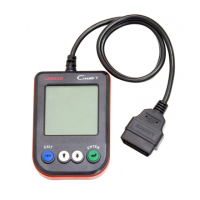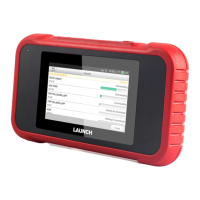10
LAUNCH
Professional 909X User Manual
2. Fuel System Monitor
This Monitor uses a Fuel System Correction program, called Fuel Trim, inside
the on-board computer. Fuel Trim is a set of positive and negative values that
represent adding or subtracting fuel from the engine. This program is used
to correct for a lean (too much air/not enough fuel) or rich (too much fuel/not
enough air) air-fuel mixture. The program is designed to add or subtract fuel,
as needed, up to a certain percent. If the correction needed is too large and
exceeds the time and percent allowed by the program, a fault is indicated by the
computer.
The Fuel System Monitor is supported by both “spark ignition” vehicles and
“compression ignition” vehicles. The Fuel System Monitor may be a “One-Trip”
or “Two-Trip” Monitor, depending on the severity of the problem.
3. Comprehensive Components Monitor (CCM)
This Monitor continuously checks all inputs and outputs from sensors, actuators,
switches and other devices that provide a signal to the computer. The Monitor
checks for shorts, opens, out of range value, functionality and “rationality* (
See
Note
).”
Rationality: Each input signal is compared against all other inputs and
against information in the computer’s memory to see if it makes sense under
the current operating conditions.
Example: The signal from the throttle position sensor indicates the vehicle is
in a wide-open throttle condition, but the vehicle is really at idle, and the idle
condition is confirmed by the signals from all other sensors. Based on the
input data, the computer determines that the signal from the throttle position
sensor is not rational (does not make sense when compared to the other
inputs). In this case, the signal would fail the rationality test.
The CCM is supported by both “spark ignition” vehicles and “compression
ignition” vehicles. The CCM may be either a “One-Trip” or a “Two-Trip” Monitor,
depending on the component.
2.6.2 Non-Continuous Monitors
“Non-continuous” Monitors perform and complete their testing once per trip. The
“non-continuous” Monitors are:
1. O
2
Sensor Monitor
The Oxygen Sensor monitors how much oxygen is in the vehicle’s exhaust. It
generates a varying voltage of up to one volt, based on how much oxygen is in
the exhaust gas, and sends the signal to the computer. The computer uses this
